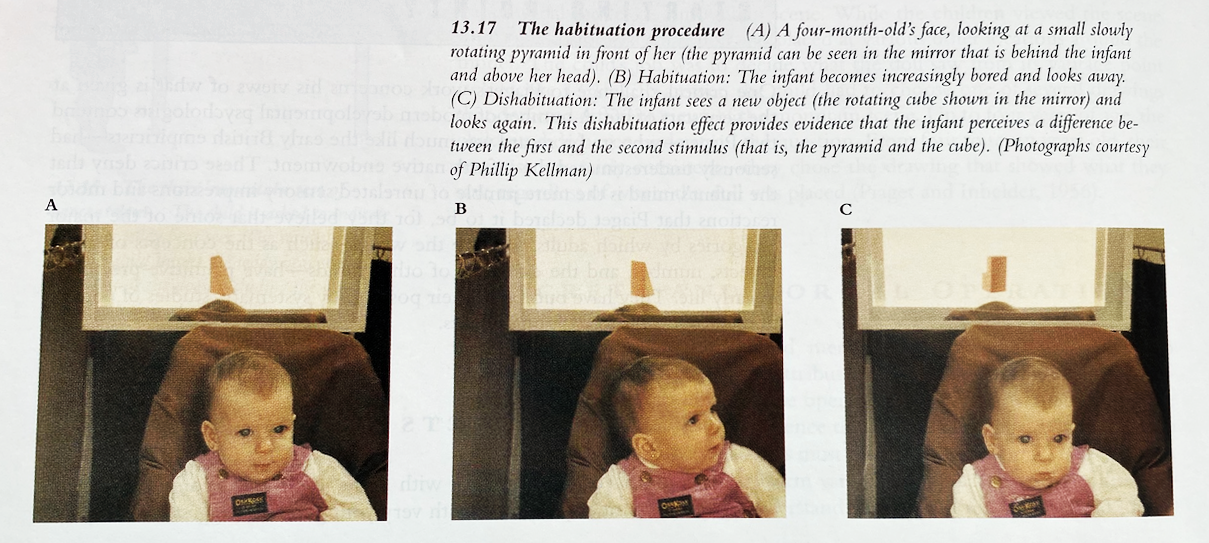Perceptual Learning: Basic Research and Modeling
In contemporary work, perceptual learning refers to experience-induced improvements in the pickup of information (Gibson, 1969). Our work in perceptual learning (PL) has several strands.
We have developed and explored the distinction between discovery and fluency effects in PL. Discovery processes involve finding and selectively extracting the information relevant to a task, including becoming sensitive to relational information that was not even encoded prior to learning. Fluency processes involve extracting the information identified by discovery processes more quickly, more in parallel, and with lower attentional load.
In recent work, we have shown the importance of perceptual learning in high-level cognitive tasks, including symbolic ones, such as mathematics learning. As Kellman & Massey (2013) wrote "Much of thinking turns out to be seeing, if seeing is properly understood." These connections require, however, revised conceptions of perception, cognition, and perceptual learning, at least with reference to common understandings of them (Kellman & Massey, 2013). A classical view, still too common, is that perception furnishes only rudimentary or sensory information. Complexities such as the spatial, temporal, causal, or animate structure of objects, situations, and events are derived from the raw materials given by perception through higher cognitive processes. In contrast, modern views of perception show that it is specialized for extraction of complex relations and meaningful structure that is directly relevant to cognitive processes. Even supposedly basic operations such as seeing the orientation of an edge or the color of a surface are results of complex computations aimed at functionally relevant descriptions of the world. Similarly, in perceptual learning, although much work in recent decades has focused on simple stimuli, we have argued that the same processes of information selection and discovery and fluent extraction of relevant relations provides a crucial basis of expertise in real-world learning domains. Some of our research has shown that even supposedly "low-level" PL depends on representations based on perceptual constancy. A great deal of work has shown the application of PL concepts to extraction of invariance from amidst variation in high-level, real-world, learning domains (see other tabs).
Finding laws of PL and deriving models of PL from our research and research by others, and using them to develop interactive learning tools that can accelerate the growth of expertise. These activities are described elsewhere on our website.
Also, in recent work we are investigating the relationship between phenomena of perceptual learning and statistical learning, concepts that are sometimes used differently and sometimes interchangeably in the research literature. Our preliminary work argues that these two forms of learning are conceptually distinguishable but may co-occur and collaborate in interesting ways that depend on learning conditions.
Perceptual Development
Our laboratory has a longstanding involvement in the development of perception in human infancy. Most recently, this is reflected in the book by Martha Arterberry and Phil Kellman Development of Perception in Infancy: The Cradle of Knowledge Revisited (Oxford University Press, 2016). This book offers a unified treatment and critical consideration of what is known about how perception develops. It updates our earlier book The Cradle of Knowledge (MIT Press, 1998).

These efforts have helped to replace conceptions of the origins of perception from protracted associative learning to a view of development clearly rooted in innate and early maturing capacities that provide meaningful perception of objects, layout, and events from early life and are fine-tuned by experience. This picture has not only replaced centuries of misunderstanding about how perception develops but also revises our understanding of the perceptual foundations that are crucial for cognitive, linguistic, and social development.
Researchers
-
 Philip J. Kellman
Philip J. Kellman -
 Christine Massey (UCLA)
Christine Massey (UCLA) -
 Everett Mettler
Everett Mettler -
 Carolyn Bufford
Carolyn Bufford -
 Victoria Jacoby
Victoria Jacoby
Collaborators
-
 Hongjing Lu (UCLA)
Hongjing Lu (UCLA) -
 Patrick Garrigan (SJU)
Patrick Garrigan (SJU) -
 Martha Arterberry (Colby College)
Martha Arterberry (Colby College)
Selected Publications
Perceptual Learning
- Jacoby, V. L., Massey, C. M., & Kellman, P. J. (2024). Adaptively triggered comparisons enhance perceptual category learning: evidence from face learning. Scientific Reports, 14(1), 19814.
- Jacoby, V. L., Massey, C. M., & Kellman, P. J. (2024). Target vs. distractor: Does the role of a category in comparisons influence learning? Evidence from skin cancer classification. In Proceedings of the Annual Meeting of the Cognitive Science Society (Vol. 46).
- Ahmad, T.R., Ashraf, D.C., Kellman, P.J., Krasne, S. and Ramanathan, S. (2024). Training visual pattern recognition in ophthalmology using a perceptual and adaptive learning module. Canadian Journal of Ophthalmology, Vol. 59, 2, e135-e141.
- Kellman, P. J., Massey, C. M., Krasne, S. & Mettler, E. (2023). Connecting adaptive perceptual learning and signal detection theory in skin cancer screening. In M. Goldwater, F. K. Anggoro, B. K. Hayes, & D. C. Ong (Eds.), Proceedings of the 45th Annual Conference of the Cognitive Science Society, 3251-3258.
- DiGirolamo, G.J., DiDominica, M., Qadri, M.A., Kellman, P.J., Krasne, S., Massey, C. and Rosen, M.P. (2023). Multiple expressions of "expert" abnormality gist in novices following perceptual learning. Cognitive Research: Principles and Implications, 8:10, 1-14. https://doi.org/10.1186/s41235-023-00462-5.
- Jacoby, V., Massey, C.M., Mettler, E.M., & Kellman, P.J. (2022). Comparisons in adaptive perceptual category learning. In J. Culbertson, A. Perfors, H. Rabagliati & V. Ramenzoni (Eds.), Proceedings of the 44th Annual Conference of the Cognitive Science Society, 2372-2378.
- Kellman, P.J., Jacoby, V., Massey, C., Krasne, S. (2022) Perceptual Learning, Adaptive Learning, and Gamification: Educational Technologies for Pattern Recognition, Problem Solving, and Knowledge Retention in Medical Learning. In: Witchel, H.J., Lee, M.W. (eds) Technologies in Biomedical and Life Sciences Education. Methods in Physiology. (pp. 135-166). Springer, Cham. https://doi.org/10.1007/978-3-030-95633-2_5
- Krasne, S., Stevens, C. D., Kellman, P. J., & Niemann, J. T. (2020). Mastering electrocardiogram interpretation skills through a perceptual and adaptive learning module. Academic Emergency Medicine Education and Training. doi: 10.1002/aet2.10454
- Mettler, E., Phillips, A., Massey, C., Burke, T., Garrigan, P., & Kellman, P. J. (2019). The synergy of passive and active learning modes in adaptive perceptual learning. In A.K. Goel, C.M. Seifert, & C. Freksa (Eds.), Proceedings of the 41st Annual Conference of the Cognitive Science Society (pp. 2351-2357). Montreal, QB: Cognitive Science Society.
- Cui, L., Massey, C. M., & Kellman, P. J. (2018). Perceptual learning in correlation estimation: The role of learning category organization. In T.T. Rogers, M. Rau, X. Zhu, & C. W. Kalish (Eds.), Proceedings of the 40th Annual Conference of the Cognitive Science Society (pp. 262-267). Austin, TX: Cognitive Science Society.
- Lerner, N., Gill, M., Scott-Parker, B. & Kellman, P.J. (2017). Accelerating driver expertise through perceptual and adaptive learning. Report to the AAA Foundation for Traffic Safety, Westat Corp.
- Arterberry, M. & Kellman, P. J. (2016). Development of Perception in Infancy: The Cradle of Knowledge Revisited (2nd ed.). Oxford: Oxford University Press. ISBN 0-199-39563-2
- Bufford, C. A., Thai, K. P., Ho, J., Xiong, C., Hines, C. A., & Kellman, P. J. (2016). Perceptual learning of abstract musical patterns: Recognizing composer style. In T. Zanto, T. Fujioka, P. Janata, J. Johnson, J. Berger, J. Slater, & C. Chafe (Eds.), Proceedings of the 14h Annual Conference of the International Conference for Music Perception and Cognition (pp. 8-12).
- Unuma, H., Hasegawa, H. , & Kellman, P.J. (2016). Perceptual learning facilitates precise mental representations of fractions. The Journal of Kawamura Gakuen Women's University, 27(1), 35-49.
- Thai, K. P., Krasne, S., & Kellman, P. J. (2015). Adaptive perceptual learning in electrocardiography: The synergy of passive and active classification. Proceedings of the 37th Annual Conference of the Cognitive Science Society. Austin, TX: Cognitive Science Society.
- Rimoin, L., Altieri, L., Craft, N., Krasne, S., & Kellman, P. J. (2015). Training pattern recognition of skin lesion morphology, configuration, and distribution. Journal of the American Academy of Dermatology, 72(3), 489-495.
- Bufford, C. A., Mettler, E., Geller, E. H., & Kellman, P. J. (2014). The psychophysics of algebra expertise: Mathematics perceptual learning interventions produce durable encoding changes. In P. Bellow, M. Guarini, M. McShane, & B. Scassellati (Eds.), Proceedings of the 36th Annual Conference of the Cognitive Science Society (pp. 272-277). Austin, TX: Cognitive Science Society.
- Mettler, E., & Kellman, P. J. (2014). Adaptive response-time-based category sequencing in perceptual learning. Vision Research, 99, 111-123.
- Kellman, P.J., & Massey, C.M. (2013) Perceptual learning, cognition, and expertise. In B.H. Ross (Ed.), The Psychology of Learning and Motivation (Vol. 58, 117-165). Amsterdam: Elsevier Inc.
- Mettler, E., Massey, C., & Kellman, P. J. (2011) Improving adaptive learning technology through the use of response times. In L. Carlson, C. Holscher, & T. Shipley (Eds.), Proceedings of the 33rd Annual Conference of the Cognitive Science Society (pp. 2532-2537). Boston, MA: Cognitive Science Society.
- Thai, K. P., Mettler, E., & Kellman, P. J. (2011). Basic information processing effects from perceptual learning in complex, real-world domains. In L. Carlson, C. Holscher, & T Shipley (Eds.), Proceedings of the 33rd Annual Conference of the Cognitive Science Society (pp. 555-560). Boston, MA: Cognitive Science Society.
- Kellman, P. J. & Garrigan, P. B. (2009). Perceptual learning and human expertise. Physics of Life Reviews, 6(2), 53-84.
- Garrigan, P.B. & Kellman, P.J. (2008). Perceptual learning depends on perceptual constancy. Proceedings of the National Academy of Sciences (USA), Vol. 105, No. 6, 2248-2253.
- Kellman, P.J. (2002). Perceptual learning. In R. Gallistel (Ed.), Stevens' handbook of experimental psychology, Third edition, Vol. 3 (Learning, motivation and emotion), John Wiley & Sons, 259-299.
- Kellman, P. J. & Arterberry, M. (1998). The cradle of knowledge: Perceptual development in infancy. Cambridge, MA: MIT Press.
Perceptual Development
- Arterberry, M. & Kellman, P. J. (2016). Development of Perception in Infancy: The Cradle of Knowledge Revisited (2nd ed.). Oxford: Oxford University Press. ISBN 0-199-39563-2
- Kellman, P. J., & Garrigan, P. (2009). Perceptual learning and human expertise. Physics of Life Reviews, 6(2), 53-84.
- Garrigan, P., & Kellman, P. J. (2008). Perceptual learning depends on perceptual constancy. Proceedings of the National Academy of Sciences, 105(6), 2248-2253.
- Kellman, P. J., & Arterberry, M. A. (2006). Infant visual perception. In D. Kuhn & R. S. Siegler (Eds.), Handbook of child psychology, volume 2: Cognition, perception, and language (6th ed., pp. 109-160). Hoboken, NJ: John Wiley & Sons.
- Kellman, P.J. (2002). Perceptual learning. In R. Gallistel (Ed.), Stevens' handbook of experimental psychology, volume 3: Learning, motivation, and emotion. (3rd ed., pp. 259-299). NY: John Wiley & Sons.
- Kellman, P. J. (2002). Vision: Occlusion, illusory contours and 'filling in'. In L. Nadel (Ed.), Encyclopedia of Cognitive Science. New York: Nature Publishing Group.
- Kellman, P. J. (2001). Separating processes in object perception. Journal of Experimental Child Psychology, 78(1) 84-97.
- Kellman, P. J. (2000). An update on Gestalt Psychology. In B. Landau, J. Sabini, J. Jonides, & E. L. Newport (Eds.), Essays in honor of Henry and Lila Gleitman (pp. 157-190). Cambridge, MA: MIT Press.
- Kellman, P. J., Burke, T., & Hummel, J. E. (1999). Modeling the discovery of abstract invariants. In B. Stankewicz & T. Sanocki (Eds.), Proceedings of The 7th Annual Workshop on Object Perception and Memory (OPAM) (pp. 48-50).
- Kellman, P. J. & Arterberry, M. (1998). The Cradle of Knowledge: Perceptual Development in Infancy. Cambridge, MA: MIT Press. ISBN 0-262-11232-9
- Hummel, J. E., & Kellman, P. J. (1998). Finding the Pope in the pizza: Abstract invariants and cognitive constraints on perceptual learning [Commentary on the paper "The development of features in object concepts" by P. G. Schyns, R. L. Goldstone, & J. Thibaut]. Behavioral and Brain Sciences, 21(1), 30.
- Kellman, P. J., & Banks, M. S. (1997). Infant visual perception. In D. Kuhn & R. S. Siegler (Eds.), Handbook of child psychology, volume 2: cognition, perception, and language (5th ed., pp. 103-146). New York: John Wiley & Sons.
- Kellman, P. J. (1996). The origins of object perception. In R. Gelman & T. K. Au (Eds.), Handbook of perception and cognition, volume 8: Perceptual and cognitive development (pp. 3-48). San Diego: Academic Press.
- Kellman, P. J. (1995). Ontogenesis of space and motion perception. In W. Epstein & S. Rogers (Eds.), Handbook of perception and cognition, volume 5: Perception of space and motion (pp. 327-364). San Diego: Academic Press.
- Slater, A., Johnson, S. P., Kellman, P. J., & Spelke, E. S. (1994). The role of three-dimensional depth cues in infants' perception of partly occluded objects. Early Development and Parenting, 3(3), 187-191.
- Shipley, T. F., Cunningham, D. W., & Kellman, P. J. (1993). Spatiotemporal stereopsis. In J. B. Stavros & V. S. Pittenger (Eds.), Proceedings of the Seventh International Conference on Event Perception and Action (pp. 279-283). Hillsdale, NJ: Lawrence Erlbaum Associates.
- Kellman, P. J. (1993). Kinematic foundations of infant visual perception. In C. E. Granrud (Ed.), Visual perception and cognition in infancy (pp. 121-173). Hillsdale, NJ: Lawrence Erlbaum Associates.
- von Hofsten, C., Kellman, P., & Putaansuu, J. (1992). Young infants' sensitivity to motion parallax. Infant Behavior and Development, 15(2), 245-264.
- Kellman, P. J., & von Hofsten, C. (1992). The world of the moving infant: Perception of motion, stability, and space. In C. Rovee-Collier & L. P. Lipsitt (Eds.), Advances in Infancy Research (Vol. 7, pp. 146-184). Norwood, NJ: Ablex.
- Sedney, K., Lerner, N., Kellman, P. & Denham, S. (1989). Childhood drownings in residential pools. Report to National Institute of Child Health and Human Development. (Contract #NO1-HD-8-2912 to COMSIS Corp.).
- Kellman, P. J. (1988). Inquiries into the origins of the mind: Blooming and still buzzing [Review of the book Neonate cognition: Beyond the blooming, buzzing confusion, edited by J. Mehler & R. Fox]. Contemporary Psychology, 33(7), 590-592.
- Kellman, P. J. (1988). Theories of perception and research in perceptual development. In A. Yonas (Ed.), Perceptual development in infancy: The Minnesota symposia on child psychology (Vol. 20, pp. 267-281). Hillsdale, NJ: Lawrence Erlbaum Associates.
- Sedney, K., Lerner, N., Cannon-Bowers, J. & Kellman, P. (1987). Evaluation of swimming pool protective devices. Report to US Consumer Product Safety Commission. (Contract #CPSC-P-87-1143 to COMSIS Corp.).
- Kellman, P. J., & Short, K. R. (1987). Development of three-dimensional form perception. Journal of Experimental Psychology: Human Perception and Performance, 13(4), 545-557.
- Kellman, P. J., Gleitman, H., & Spelke, E. S. (1987). Object and observer motion in the perception of objects by infants. Journal of Experimental Psychology: Human Perception and Performance, 13(4), 586-593.
- Kellman, P. J., von Hofsten, C., & Soares, J. (1987). Concurrent motion in infant event perception. Infant Behavior and Development, 10(1), 1-10.
- Kellman, P. J., Spelke, E. S., & Short, K. R. (1986). Infant perception of object unity from translatory motion in depth and vertical translation. Child Development, 57(1), 72-86.
- Kellman, P. J. (1984). Perception of three-dimensional form by human infants. Perception & Psychophysics, 36(4), 353-358.
- Kellman, P. J., & Cohen, M. H. (1984). Kinetic subjective contours. Perception & Psychophysics, 35(3), 237-244.
- Kellman, P. J., & Spelke, E. S. (1983). Perception of partly occluded objects in infancy. Cognitive Psychology, 15(4), 483-524.

